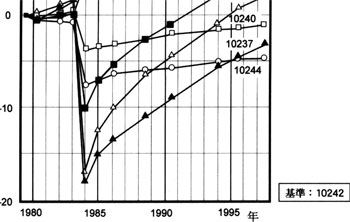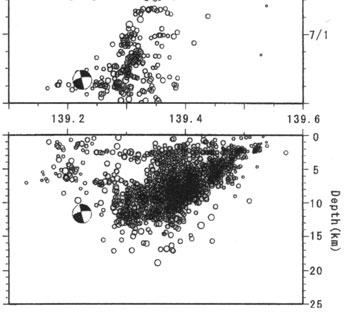Miyakejima Volcano
1: Introduction / 2: Topography of Miyakejima Volcano
3: History of eruptions of Miyakejima Volcano
4: Eruption of 2000 and collapse of the summit
5: Rocks of the Miyakejima Volcano
6: Possible future activities and hazard prediction / 7: Observation and monitoring
References
![]() PREV
PREV ![]() NEXT
NEXT
4: Eruption of 2000 and collapse of the summit
The volcano was being quite deflated following large 1983 eruption, but the mode changed to inflation and uplift related to accumulation of magma with SW flank as its center ( ![]() Fig. 4 ). By late 1990s the subsidence was almost restored and possibility of eruptions in the near future became certain.
Fig. 4 ). By late 1990s the subsidence was almost restored and possibility of eruptions in the near future became certain.
From about 18:30 on June 26th 2000, frequent earthquakes and rapid inflation of the volcanic body were observed, consequently emergency volcanic hazard warning was issued by the authority. In the early morning of the next day a small eruption occurred on the sea floor off Ako, but there was no eruption on land. Center of earthquake activity shifted from Miyakejima to a region of Kozushima and Niijima 30 km to the NW ( ![]() Fig. 5 ). This was interpreted as corresponding to rising magma and its shift. On July 8th a small eruption occurred at the summit and at the same time the summit of Oyama about 1 km across collapsed. Collapse had grown day after day and by the end of August the size reached 1.6 km across 450 m deep overlapping Hatchodaira caldera. A phreatomagmatic eruption occurred at this collapse caldera on July 14th to 15th and again on August 10th. In the evening of August 18th, an exceptionally violent eruption occurred, by which a block of rock with diameter of 50 cm was blown 3.5 km to reach the island highway. At this explosion the eruption column rose to 15,000 m.
Fig. 5 ). This was interpreted as corresponding to rising magma and its shift. On July 8th a small eruption occurred at the summit and at the same time the summit of Oyama about 1 km across collapsed. Collapse had grown day after day and by the end of August the size reached 1.6 km across 450 m deep overlapping Hatchodaira caldera. A phreatomagmatic eruption occurred at this collapse caldera on July 14th to 15th and again on August 10th. In the evening of August 18th, an exceptionally violent eruption occurred, by which a block of rock with diameter of 50 cm was blown 3.5 km to reach the island highway. At this explosion the eruption column rose to 15,000 m.
In the early morning of August 29th, low temperature ( about 30?C )/low speed ( 10 km per hour ) pyroclastic flow came down to the north foot and SW flank ( ![]() Fig. 6 ). Apparent total volume of year 2000 ejecta is estimated to be about 0.01 km3 ( Nakata et al., 2001 ), which is comparable to those of 1940, 1962, and 1983. However, most of ejecta were fragmented pre-existed lava and altered lava, and the highest content of essential materials was only 40 % for the ejecta of August 18th ( Utsu et al., 2001 ). On the other hand, the volume of collapse was 0.6 km3 which was 50 times as large as that of ejected ( Nakata et al., 2001 ). From late August 2000, the volcanic smoke and gas including sulfur dioxide increased remarkably, and all the residents had to evacuate from the island. Emission of quantities of volcanic gas has continued and small eruptions several times a year are occurring since.
Fig. 6 ). Apparent total volume of year 2000 ejecta is estimated to be about 0.01 km3 ( Nakata et al., 2001 ), which is comparable to those of 1940, 1962, and 1983. However, most of ejecta were fragmented pre-existed lava and altered lava, and the highest content of essential materials was only 40 % for the ejecta of August 18th ( Utsu et al., 2001 ). On the other hand, the volume of collapse was 0.6 km3 which was 50 times as large as that of ejected ( Nakata et al., 2001 ). From late August 2000, the volcanic smoke and gas including sulfur dioxide increased remarkably, and all the residents had to evacuate from the island. Emission of quantities of volcanic gas has continued and small eruptions several times a year are occurring since.
This series of activities including earthquakes were interpreted by shifting of reservoir magma from below the Miyakejima to NE direction resulting in collapse. The distance between Kozushima and Niijima has stretched nearly 1 m by those magma intrusion and shift ( ![]() Fig. 7 ).
Fig. 7 ).



